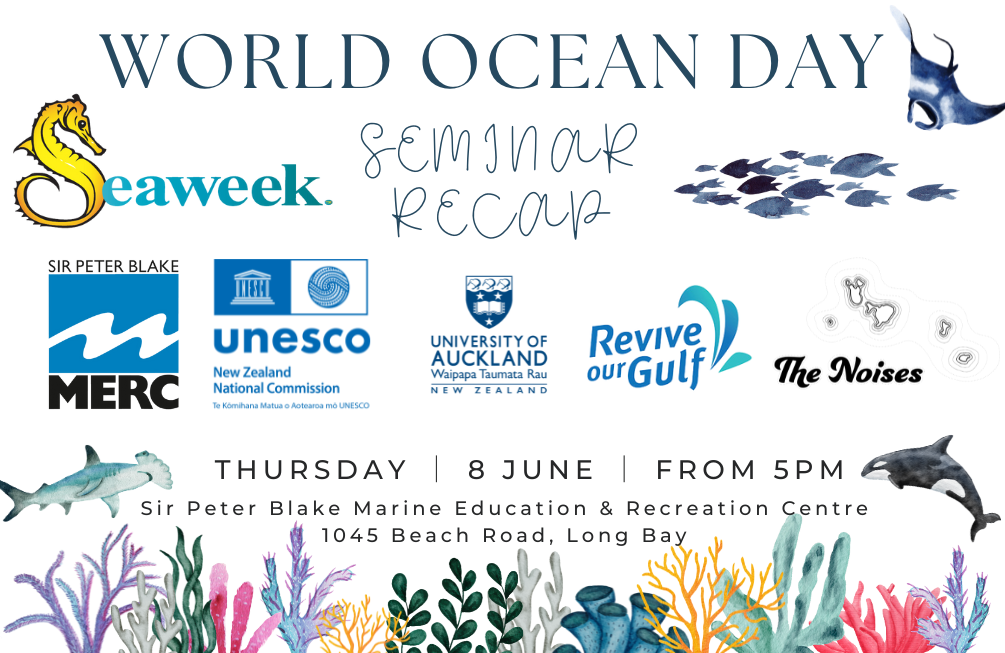
To celebrate World Ocean Day, we gathered together at the Sir Peter Blake Marine Education and Recreation Centre (MERC) in Long Bay to learn more about our big blue backyard.
Our guest speakers discussed research and restoration initiatives in the Hauraki Gulf Marine Park, Tīkapa Moana Te Moananui-ā-Toi. You can learn a little about what was included in the presentations in the summary below or scroll further down the page to get to the event recording.
Overall Event Summary
A group swim at Long Bay Beach set the tone for the evening and gave participants the opportunity to physically connect with nature and each other; reaping the benefits of physically connecting with our sea - despite winter water temps! The chilly dip at sunset was followed by warm drinks and food; vegetable soups and snacks for everyone gathered in the hall. The seminar was focused on restoration initiatives in Tīkapa Moana and featured speakers from Revive Our Gulf, The Noises Trust, and the University of Auckland Leigh Marine Laboratory. Discussed topics included the widespread loss of kūtai (green-lipped mussel) beds throughout the Hauraki Gulf, the prevalence of kina barrens and the evidence of other human impacts.
Katina Conomos ~ Programme Director at Revive Our Gulf
Katina Conomos, programme director at Revive Our Gulf, discussed the organisation's work so far and what they are working towards to restore kūtai beds across the Hauraki Gulf. Kūtai beds are essential to Hauraki Gulf marine ecosystems but have declined significantly because of seafloor dredging and over-collection. By reintroducing mussels to their historical ranges, Revive Our Gulf aims to protect other native marine species that rely on mussels for food, shelter, wave attenuation, and water quality. Revive Our Gulf is a collaboration between the Nature Conservancy, the University of Auckland, the Mussel Reef Restoration Trust and iwi.
Kelsey Miller ~ Marine Scientist at the University of Auckland's Leigh Marine Laboratory
Kelsey Miller is a PhD candidate at Leigh Marine Lab, her recent research focuses on the recovery of kelp forests in New Zealand following kina removal in experimental areas. As a result of decreased predator numbers kina density is found to be increasing on many Hauraki Gulf rocky reefs. Experiments have revealed that overgrazed reef habitats where kelp used to be plentiful can recover following kina removal. These recoveries can occur over very short time periods but require ongoing kina removal for these kelp forests to be sustained. Kelsey's presentation highlighted that while removal of kina is not a solution for restoring reefs there is a lot more to learn about helping these habitats to recover.
Sue Neureuter ~ Custodian of The Noises
Sue Neureuter is a passionate and dedicated advocate for marine protection around The Noises Islands. The Noises, located in the inner Hauraki Gulf, are a fascinating and beautiful place; rich with native terrestrial and marine wildlife as well as an important site for archaeological research. During the seminar, Sue explained that overfishing and sedimentation within the Hauraki Gulf have significantly impacted the marine ecosystem at the Noises. She explained that the marine biodiversity surrounding the islands would continue to decline without establishing an adequately sized marine protected area. For this reason, the Neureuters, Auckland Museum, and the University of Auckland have been a key part of proposing marine protection surrounding the islands.
Seminar recording
For more information, check out these links:
Revive Our Gulf website: reviveourgulf.org.nz
The Noises website: thenoises.nz
Kelsey Miller's profile on the University of Auckland website: profiles.auckland.ac.nz/kmil284